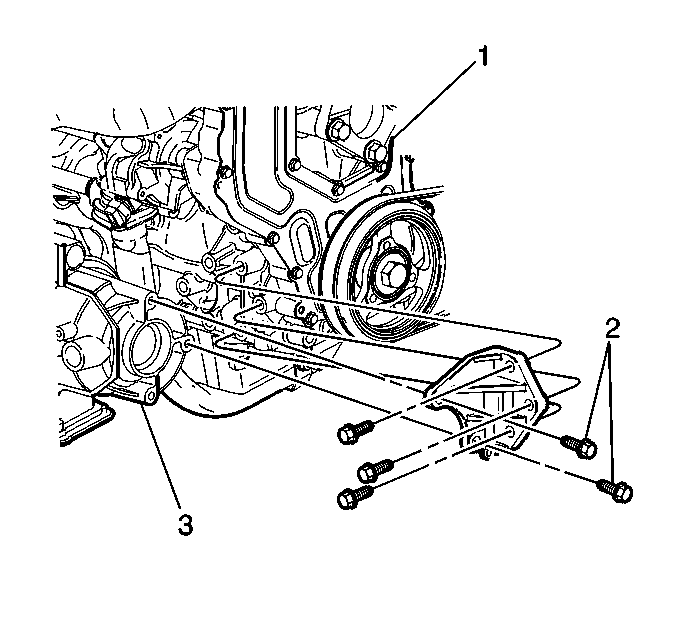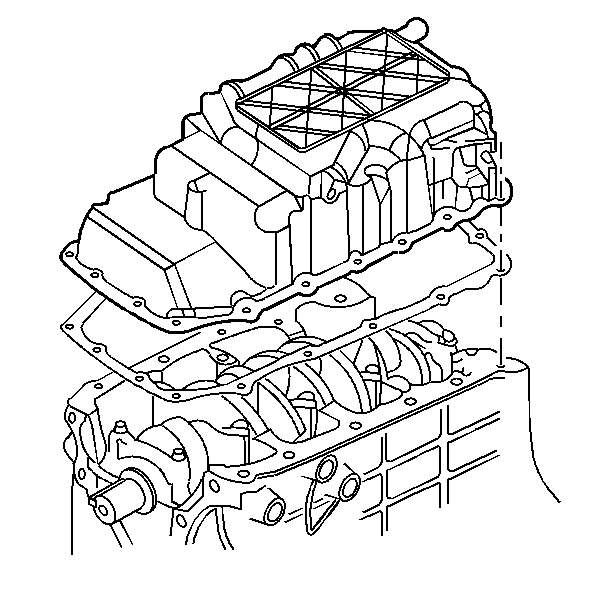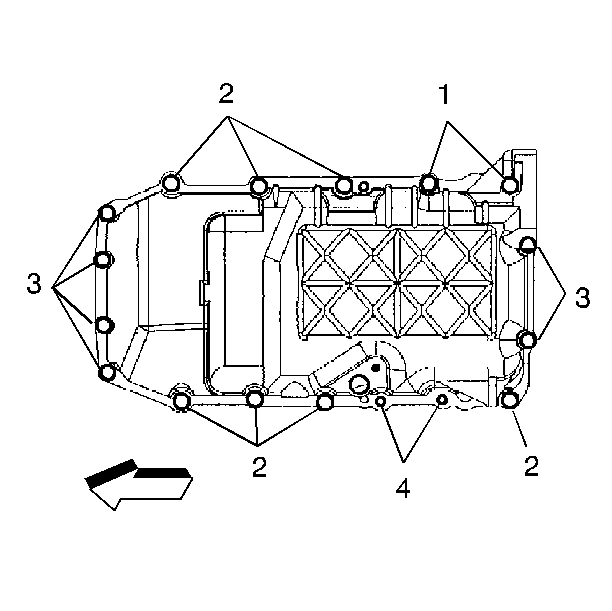Removal Procedure
- Disconnect the negative battery cable.
- Install the engine support fixture. Refer to Engine Support Fixture .
- Remove the engine mount. Refer to Engine Mount Replacement .
- Raise the engine approximately 3.8 cm (1.5 in).
- Raise and support the vehicle. Refer to Lifting and Jacking the Vehicle in General Information.
- Drain the engine oil.
- Drain and recover the coolant. Refer to Cooling System Draining and Filling in Engine Cooling.
- Remove the flywheel dust shield.
- Remove the right front wheel and tire assembly.
- Remove the right splash shield. Refer to Wheelhouse Splash Shield Replacement in Body Front End.
- Remove the drive belt. Refer to Drive Belt Replacement
- Remove the A/C compressor lower bolts. Refer to Air Conditioning Compressor Replacement in HVAC Systems with A/C - Manual.
- Remove the brace (3) which supports the transmission to the engine.
- Remove the radiator outlet pipe. Refer to Engine Coolant Inlet Pipe Replacement in Engine Cooling.
- Remove the bolt and the nut which secure the oil pan to the flywheel cover.
- Remove the flywheel cover stud for clearance.
- Remove the oil pan bolts.
- Remove the oil pan and gasket.
Caution: Unless directed otherwise, the ignition and start switch must be in the OFF or LOCK position, and all electrical loads must be OFF before servicing any electrical component. Disconnect the negative battery cable to prevent an electrical spark should a tool or equipment come in contact with an exposed electrical terminal. Failure to follow these precautions may result in personal injury and/or damage to the vehicle or its components.


Clean the engine block and oil pan surfaces. Refer to Oil Pan Cleaning and Inspection .
Installation Procedure
- Install the oil pan and gasket.
- Tighten the oil pan bolts as shown in the illustration.
- Install the nut which secures the oil pan to the transmission.
- Install the radiator outlet pipe. Refer to Engine Coolant Inlet Pipe Replacement in Engine Cooling.
- Install the radiator outlet pipes to the oil pan.
- Install the radiator outlet pipe bolts. Refer to Engine Coolant Inlet Pipe Replacement in Engine Cooling.
- Install the brace which supports the transmission to the engine.
- Install the A/C compressor bolts. Refer to Air Conditioning Compressor Replacement in HVAC Systems with A/C - Manual.
- Install the drive belt. Refer to Drive Belt Replacement
- Install the right splash shield. Refer to Wheelhouse Splash Shield Replacement in Body Front End.
- Install the right front wheel and tire assembly.
- Install the flywheel housing dust shield.
- Fill the cooling system. Refer to Cooling System Draining and Filling in Engine Cooling.
- Fill the crankcase with oil to the appropriate level. Use recommended oil. Refer to Engine Oil and Oil Filter Replacement
- Lower the vehicle.
- Lower the engine approximately3.81N cm (1.5 in).
- Install the engine mount. Refer to Engine Mount Replacement .
- Remove the engine support fixture. Refer to Engine Support Fixture .
- Connect the negative battery cable.


Notice: Use the correct fastener in the correct location. Replacement fasteners must be the correct part number for that application. Fasteners requiring replacement or fasteners requiring the use of thread locking compound or sealant are identified in the service procedure. Do not use paints, lubricants, or corrosion inhibitors on fasteners or fastener joint surfaces unless specified. These coatings affect fastener torque and joint clamping force and may damage the fastener. Use the correct tightening sequence and specifications when installing fasteners in order to avoid damage to parts and systems.
Tighten
| • | (1) (M8 X 1.25 X 80) 24 N·m (18 lb ft). |
| • | (2) (M8 X 1.25 X 22) 24 N·m (18 lb ft). |
| • | (3) (M6 X 1.00 X 25) 12 N·m (106 lb in). |
| • | (4) 26 N·m (19 lb ft). |
Tighten
Tighten the bolts to 50 N·m (37 lb ft) in
sequence.
